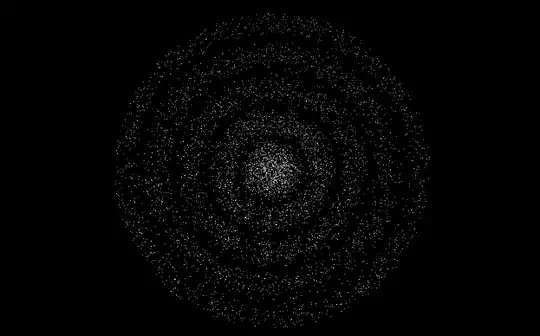Some questions that look kind of similar have been asked before, and I find the answers quite confusing. I intend to ask this question in a way that clearly shows what I'm asking.
Imagine the following thought-experiment. (I don't know whether it's practical to actually do the experiment or not.)
Set up the usual double-slit experiment with a photon source that sends one photon at a time. But replace the double slits with a single pinhole. Over a period of time you should observe a diffraction pattern that looks something like this:
Now in front of the pinhole, put a metal disk with slots cut in it, that can spin.
When a slot is entirely in front of the pinhole, it should have very little effect on photons that go through the pinhole. Maybe some minimal diffraction.
When the solid disk is entirely in front of the pinhole, hardly any photons should get through. A few might take the long route around the solid metal disk and through a slot, or around the outside edge of the disk.
When the edge of a slot is close to the pinhole, it might create an observable diffraction pattern different from the open one. You can observe those effects by rotating the disk to various angles and waiting for the diffraction pattern to form.
When the disk spins, then sometimes photons can get through the pinhole and other times they can't. Most photons are independent of all of the others. (If our photon-emitter releases them at random times, very occasionally two might go through the pinhole at similar times.)
The faster the disk spins, the shorter the times that photons can get through. We can vary two things -- the rotation speed of the disk, and the "wavelength" of the photons.
My assumption from a naive reading, is that photons are point particles that travel at lightspeed. So no matter how fast the disk spins, it should have no effect on the diffraction pattern.
But classically, radiation came from an accelerated charge. A single charge with an oscillatory motion would produce a wave, and if it oscillated a thousand times then the wave it produced might continue for a thousand wavelengths.
What happens in reality? Does our single-photon source produce point-particle photons which are entirely unaffected by the spinning disk except when an edge is close to the pinhole? Or does it produce photons that have a length, that can be interrupted by the spinning disk? If they are each a thousand wavelengths long, then at some wavelength and at some rotation speed they will all be affected. If they are one wavelength long, similarly at some speed they will all be affected.
Maybe the reality simply does not match up to point-particle photons that have special properties which make them each behave statistically like a wave. And it doesn't match up to literal waves either. If these concepts are useful teaching tools that don't really fit, it would be interesting to get a clear idea what to replace them with.
